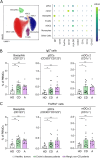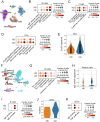The Role of IgE in Crohn's Disease by Impairing the Capacity of Plasmacytoid Dendritic Cells to Generate FOXP3+ Tregs
- PMID: 40052502
- PMCID: PMC12368764
- DOI: 10.1111/all.16517
The Role of IgE in Crohn's Disease by Impairing the Capacity of Plasmacytoid Dendritic Cells to Generate FOXP3+ Tregs
Abstract
Background: A causal relationship between Crohn's disease (CD) and asthma is reported, but the underlying mechanisms are not fully understood. We sought to investigate the role of IgE and IgE-mediated pathways in the pathophysiology of CD.
Methods: 20 CD patients, 10 allergic patients without inflammatory bowel disease, and 10 healthy donors (HD) were included in the study. Total serum IgE was quantified by ELISA. Circulating IgE+ and FcεRIα+ immune cells, as well as specific CD4+ T cell populations, were determined by flow cytometry. Gene set enrichment signatures from available single-cell (sc)RNAseq datasets of the intestine from CD patients were analyzed. Purified plasmacytoid dendritic cells (pDCs) from CD patients were cocultured with naïve CD4+ T cells to assess Tregs generation.
Results: CD patients, similar to allergic non-CD patients, displayed significantly higher numbers of circulating IgE+ or FcεRIα+ immune cells than HD. The percentage of blood IgE+ or FcεRIα+ pDCs was significantly higher in CD than HD and similar to allergic non-CD patients. CD patients showed significantly higher numbers of effector memory CD4+ T cells and lower numbers of FOXP3+ Tregs than HD. scRNAseq data from CD patients confirmed that Tregs imbalance and overactivation of IgE-mediated pathways take place also in gut tissues of children and adults, suggesting IgE could interfere in the pDC-Tregs axis. In vitro functional experiments demonstrated that IgE-crosslinking on pDCs from CD patients impairs Treg generation, which was restored by the anti-IgE mAb omalizumab.
Conclusions: IgE might play an unprecedented role in CD by impairing the capacity of pDCs to generate Tregs, which could represent a novel mechanism contributing to CD to be exploited for alternative therapeutic interventions.
Keywords: Crohn's disease; IgE; plasmacytoid dendritic cells; regulatory T cells.
© 2025 The Author(s). Allergy published by European Academy of Allergy and Clinical Immunology and John Wiley & Sons Ltd.
Conflict of interest statement
O.P. received research grants from MINECO, Ministerio de Ciencia e Innovación, CAM, Inmunotek S.L., Novartis, and AstraZeneca, and fees for giving scientific lectures or participation in Advisory Boards fromAstraZeneca, Pfizer, GlaxoSmithKline, Inmunotek S.L., Novartis, Sanofi‐Genzyme, and Regeneron. P.T. and X.J. are Novartis employees. C.T. has served as a speaker, consultant, and advisory board member for MSD, AbbVie, Pfizer, Takeda, Janssen, Galapagos, Lilly, Fresenius Kabi, Ferring, Faes Farma, Shire Pharmaceuticals, Dr. Falk Pharma, and Tillots. The rest of the authors declare no competing financial interests.
Figures





References
-
- Ng S. C., Shi H. Y., Hamidi N., et al., “Worldwide Incidence and Prevalence of Inflammatory Bowel Disease in the 21st Century: A Systematic Review of Population‐Based Studies,” Lancet 390 (2017): 2769–2778. - PubMed
-
- Roda G., Chien Ng S., Kotze P. G., et al., “Crohn's Disease,” Nature Reviews Disease Primers 6 (2020): 22. - PubMed
-
- Torres J., Mehandru S., Colombel J. F., and Peyrin‐Biroulet L., “Crohn's Disease,” Lancet 389 (2017): 1741–1755. - PubMed
-
- Baumgart D. C. and Le Berre C., “Newer Biologic and Small‐Molecule Therapies for Inflammatory Bowel Disease,” New England Journal of Medicine 385 (2021): 1302–1315. - PubMed
MeSH terms
Substances
Grants and funding
LinkOut - more resources
Full Text Sources
Medical
Research Materials

